







During June 2022 to September 2022 the SWT/KWS Sky Vet program was called to handle 30 wildlife cases involving 17 elephants, 1 lion, 2 rhinos, 2 zebra, 6 giraffe, 1 buffalo and 1 hippo Over this reporting period the number of poaching cases has drastically increased.


Of the 17 elephant cases, 12 were directly related to poaching; 5 snares, 3 spear and 4 arrow injuries The Unit also attended to one natural case and rescued 3 infant elephants, 2 were taken to the orphanage, but sadly one in Northern Kenya was found with a broken spine and had to be euthanised. A mother and calf were also rescued after they became stuck in a muddy dam in Lunga Lunga, South Coast. This was a huge undertaking involving the aerial units, ground teams and community. One infant Black rhino was also rescued from Ol Pejeta after it was found abandoned and injured by hyenas and an adult White rhino was treated after it became entangled in fencing wire.
The lion was treated for an injury due to territorial fights whilst all the other species (zebra/giraffe/buffalo/hippo) were all treated for poaching injuries.
Out of the cases treated there was an 70% success rate, 12% taken to an orphanage and 12% death due to poaching.
The Sky Vet program has deployed KWS vets to the following locations during this reporting period

30

Attended to by the SWT/KWS Sky Vet Unit June - September 2022

On the 6th of June 2022 a baby orphaned elephant was rescued in northern Kenya.

Sadly, on arrival at the scene it was discovered the calf had a broken leg and then after it had been transported by chartered helicopter to Ol Malo for further care the team realised the injuries were far worse and the calf’s spine was also broken.
Very sadly there was no other alternative other than to euthanise the calf.
SWT air and ground units spotted the calf with severe lameness caused by a wire snare on its right forelimb.
The calf had a severely swollen limb and struggled to keep up with his protective family given the pain he was under. The calf was darted from a helicopter with 3.5mg Etorphine hydrochloride delivered using a 1.5 ml Dan-Inject dart. The drugs took effect in 6 minutes and the calf was revived thereafter with 40mg Naltrexone and 60mg Azaperone to keep him calm.
The wire snare had cut deep into his right carpus, infection had set in and necrotic tissue was observed. The snare was removed, and the wound cleaned with Hydrogen peroxide, rinsed with fresh water and disinfected with Iodine. Green clay was then packed into the wound. Amoxicillin antibiotics and Flunixin meglumine antiinflammatories were also administered intra-muscularly.
After treatment, he was reunited with his family that had been waiting nearby. Ground teams were instructed to monitor the calf for possible follow up treatment.
The calf has a guarded prognosis due to the severity of his injury.
No pictures are available for this case.
The 18 month old calf was found alone with no family nearby. Ranch management and Wildlife Works rangers kept him safe and informed the Tsavo Mobile Veterinary Unit.
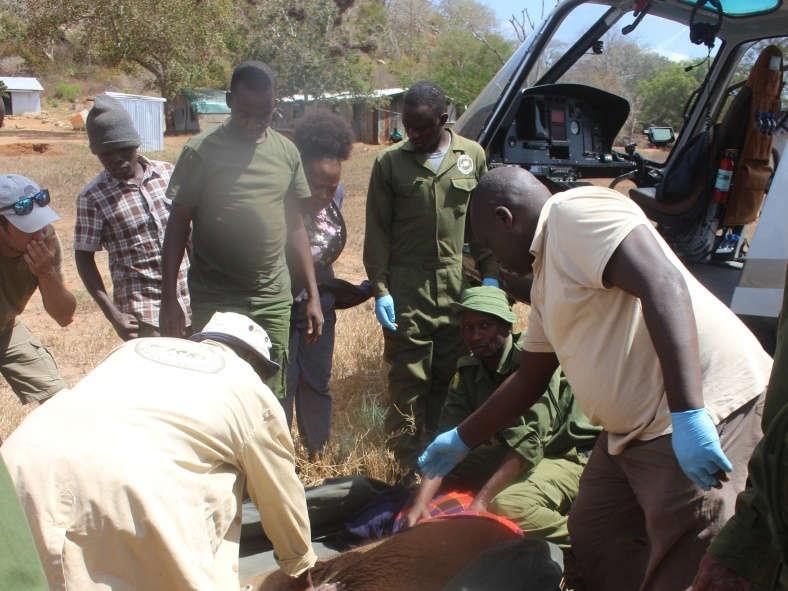
The calf had been restrained by the rangers that found him. He was healthy and had good body condition. Oral rehydration to restore lost fluid was given after which he was loaded onto a helicopter and airlifted to the Sheldrick Wildlife Trust Elephant Nairobi Nursery for further care and management.



The calf had good prognosis since he was found in good health.
The giraffe was seen by Conservancy and KWS rangers with a tight snare around his right hind leg.
The snare injury was so severe that it had almost severed the limb at the fetlock joint. The giraffe was darted with a combination of 14mg Etorphine and 60mg Azaperone delivered in a 3 ml Dan inject dart from a helicopter. The drugs took effect within 10 minutes.
Examination revealed an infected limb with an almost severed fetlock joint caused by a tight nylon snare.
The giraffe was in fair body condition. However, he had a grave prognosis given the extent of his injuries. He was euthanized to spare him further pain and suffering.
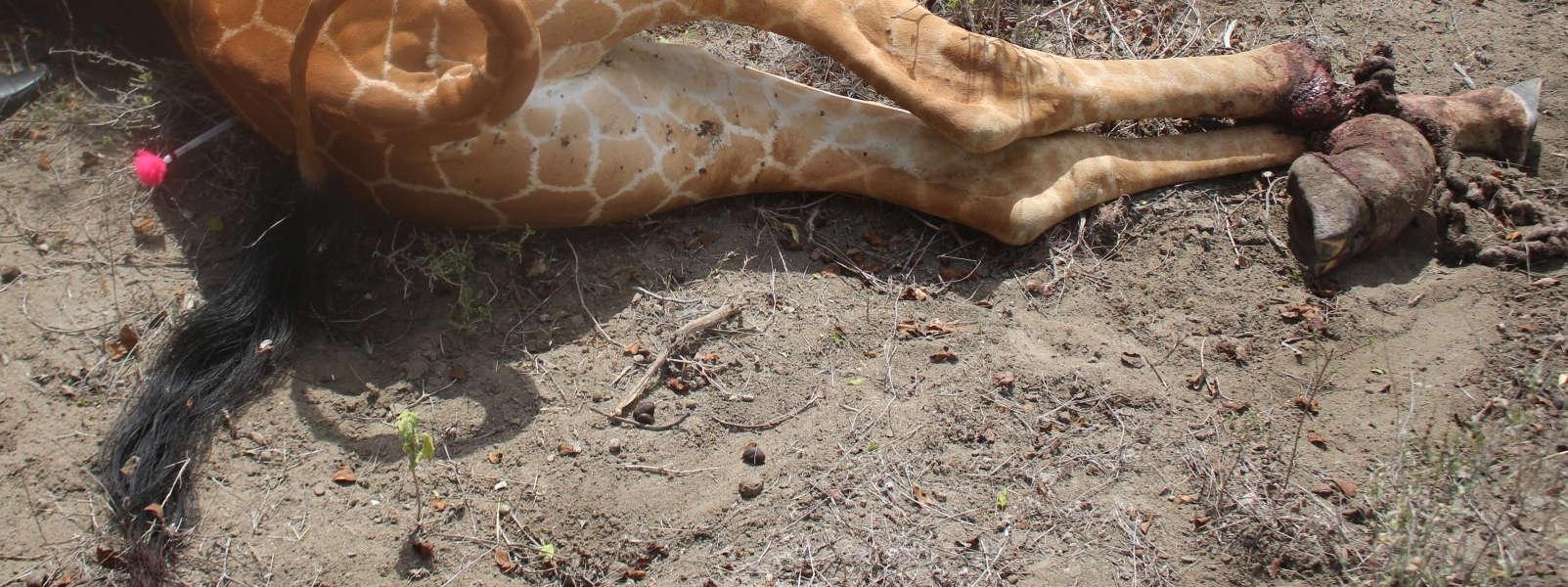

The giraffe was spotted walking with difficulty by Big Life Foundation rangers due to a snared left hind limb.


The giraffe had a braided wire snare deeply embedded into maggot infested soft tissues around the fetlock joint of its left hind limb. He was chemically immobilized with a combination of 16mg Etorphine hydrochloride and 60mg Azaperone delivered by a 3 ml Dan-inject dart. The drugs took effect in 12 minutes. Reversal was done immediately with 36mg Diprenorphine hydrochloride and 40mg Naltrexone then he was manually restrained by pinning his head to the ground.
The wire snare had cut deep into soft tissue and the resulting wound had become septic and maggot infested. Upon removing the snare, the wound was cleaned with Hydrogen peroxide and rinsed with water. It was disinfected with Iodine and green clay applied to promote healing. Amoxicillin antibiotics and flunixin meglumine anti-inflamatories were then administered.
He was assisted to rise after which he galloped away. The giraffe has a good prognosis.
A blood trail was found along the road by KWS Rangers on patrol. The blood trail and elephant spoor was followed to an area with thick bush where the injured elephant bull was located with assistance from the SWT aerial patrol.

The elephant bull had trouble breathing and walking, he was also bleeding from a thoracic injury that was oozing pus and necrotic tissue. The bull was darted from a helicopter with 20mg Etorphine hydrochloride delivered through a 3 ml Dan-inject dart. He was fully anaesthetized after 12 minutes.
Closer examination revealed two deep penetrating wounds on the right thoracic region with an active bleeder. The wounds had become septic with pus and necrotic tissue visible. Deep muscle tissues and organs had also become gangrenous. Sadly, this magnificent bull died during treatment.
The post-mortem examination found a septic spear injury on his right chest about a week old. The deep wound was causing adhesion around the lungs resulting in dyspnea that was exacerbated by immobilization.
The young bull, approx. 14 years old, was captured by a camera trap mounted at a watering point within the sanctuary with a plain fence wire around his left hind leg.
The bull was found deep within the sanctuary the following day with assistance from the SWT air-wing. The fence wire was deeply embedded in the limb that was swollen and septic with necrotic tissue. The elephant was immobilized with 15mg Etorphine hydrochloride delivered remotely via a 1.5 cc Dan-Inject dart from a helicopter.
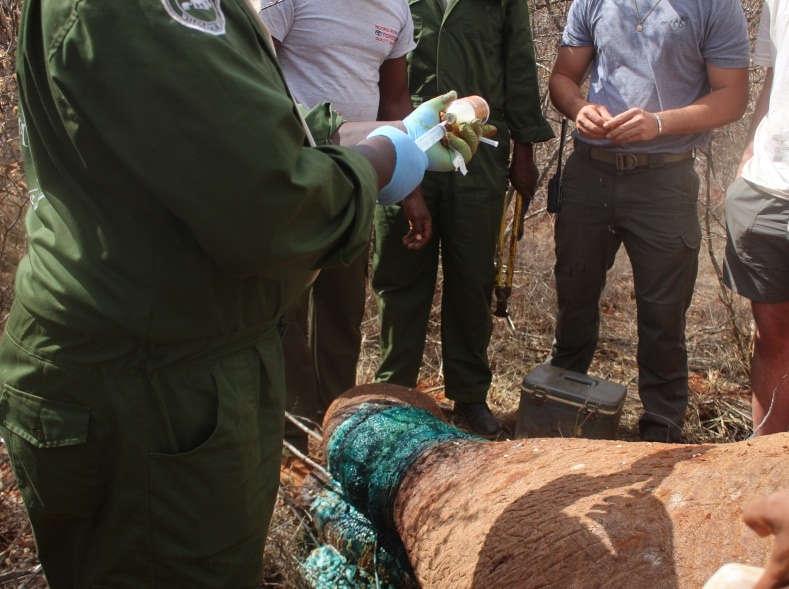
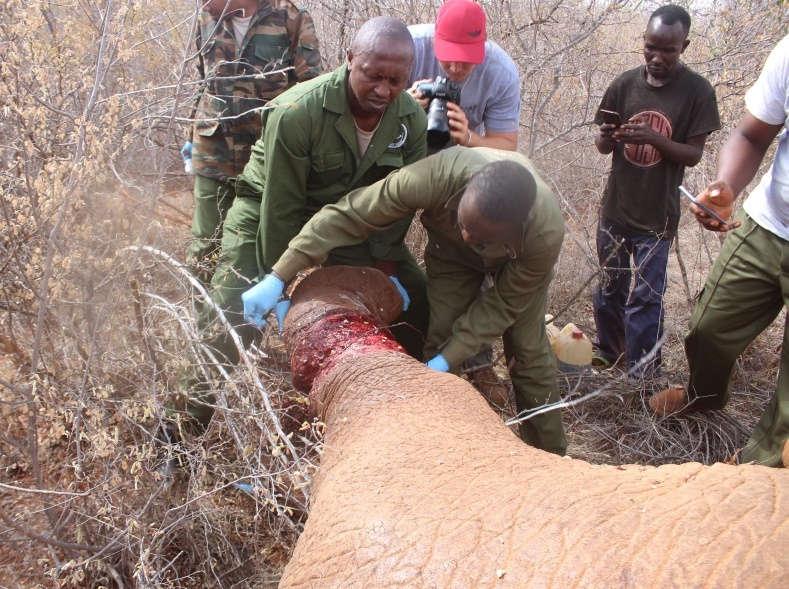


The wire was removed then the wound was thoroughly debrided and flushed with Hydrogen peroxide and water then disinfected with Iodine. Green clay and Oxytetracycline spray was applied after which antibiotics and anti-inflammatories were administered.
The bull was revived with 36mg Diprenorphine and 40mg Naltrexone administered intravenously through a prominent ear vein. He was up in one and a half minutes and retreated into some deep thickets nearby. The elephant was treated su
The
which was swollen.
The SWT air-wing located the injured elephant and alerted the veterinary unit. She appeared to be in severe pain since she could not put weight on her swollen limb. She was immobilized with 18mg etorphine hydrochloride and was fully anaesthetized 7 minutes later.


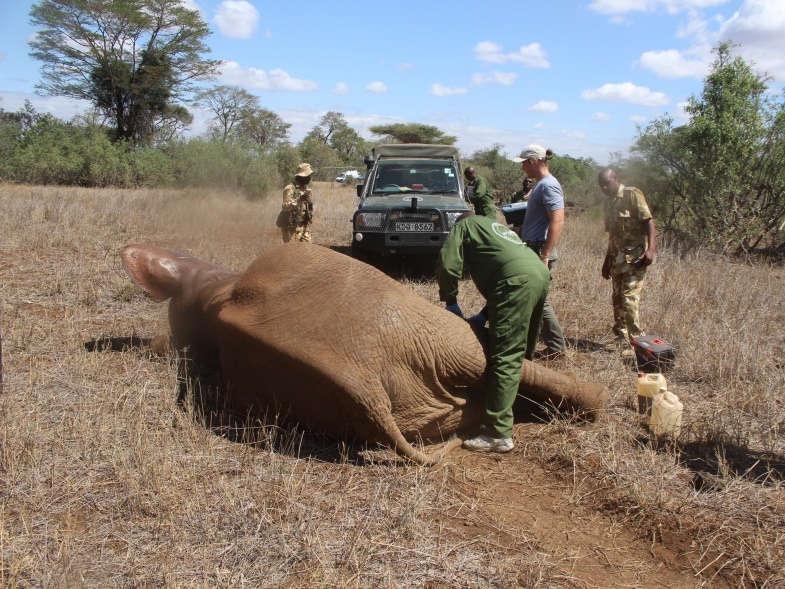
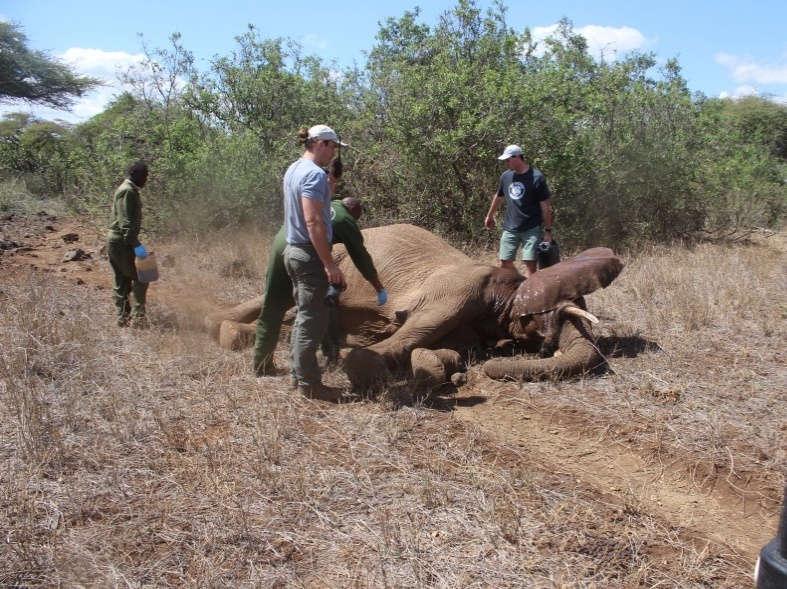
Examination revealed that she had a deep spear wound on the side of her right hind limb just above her knee. The injury had extended to the knee joint but the joint capsule had been spared. The wound was debrided and flushed with hydrogen peroxide and water. Iodine was used for disinfection and chlortetracycline boluses inserted into the wound followed by natural green clay. Antibiotics and antiinflammatories were administered as well. She was then revived with 36 mg diprenorphine and 40 mg naltrexone administered intravenously through a prominent ear vein. She was up in 2 minutes and re-joined her family that was waiting nearby.
The elephant cow has a favourable prognosis.
The Naibosho conservancy warden reported an injured elephant bull and a snared giraffe in the conservancy. As the resident Vet was away, a Vet from KWS HQ Nairobi was airlifted by SWT helicopter to attend the case.



The team arrived at the conservancy airstrip and were picked up by the ground team and driven to the site where rangers were keeping an eye on the elephant bull. The bull was spotted foraging and moving slowly with an obvious injury on the neck just above the right eye. 18mgs of Etorphine was loaded into a Dan-inject dart gun and the elephant approached using a vehicle. He was darted in the rump and immediately fled towards the nearby bush. Attempts to prevent him from entering the thick bush were futile. After 8 minutes he went down in sterna recumbency with trees preventing him being pushed over to lateral recumbency. The team quickly treated the deep spear wound above the eye by draining the pus and flushing with antimicrobials. A final cover of green clay was applied to the wound. Long acting antibiotics and antiinflammatories were also applied then the anaesthetic was reversed.

The elephant has a good prognosis.
The Naibosho conservancy warden reported an injured elephant bull and a snared giraffe in the conservancy. As the resident Vet was away, a Vet from KWS HQ Nairobi was airlifted by SWT helicopter to attend the case.



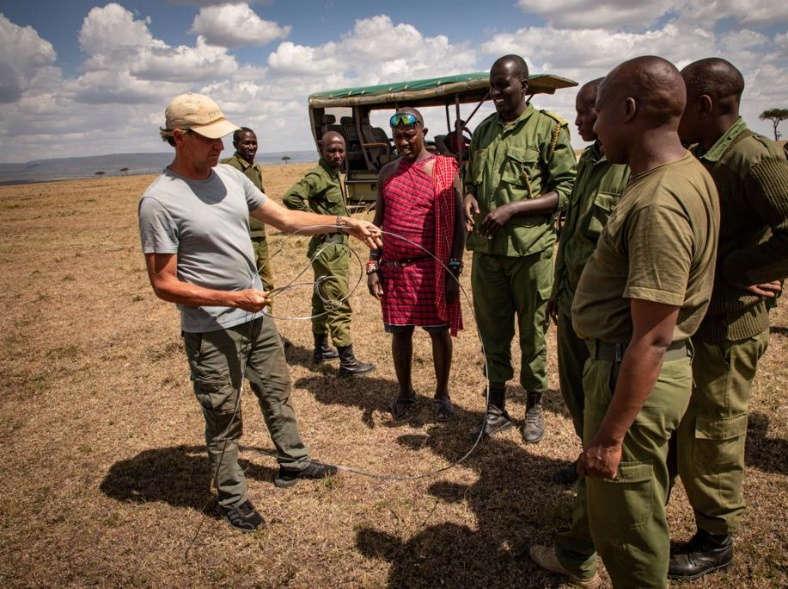
The snared Giraffe was easily spotted among several others in the conservancy with a wire snare dangling around the neck. Drugs and darting equipment were prepared and the Giraffes pushed into a clearing and darted dan-inject dart containing 15 mgs of Etorphine hcl. She ran away but was prevented from entering bushy areas. After the drug had taken effect the Giraffe was roped down and anaesthesia reversed by use of Diprenorphine at 3 times the etophine dose and held down by the neck. The snare was removed and as there was no injury to the neck the Giraffe was released by being assisted to a sitting position where she stood up and walked away slowly to join the rest of the herd.
The prognosis is good as the snare didn’t cause any injury.
This zebra was observed to be dragging a winch wire snare from her neck. It had strangled her to an extent she had difficulty in breathing and it had cut deep into the neck tissues. The Big Life Wildlife Team and KWS patrol team reported the case to the Mobile Veterinary Unit.


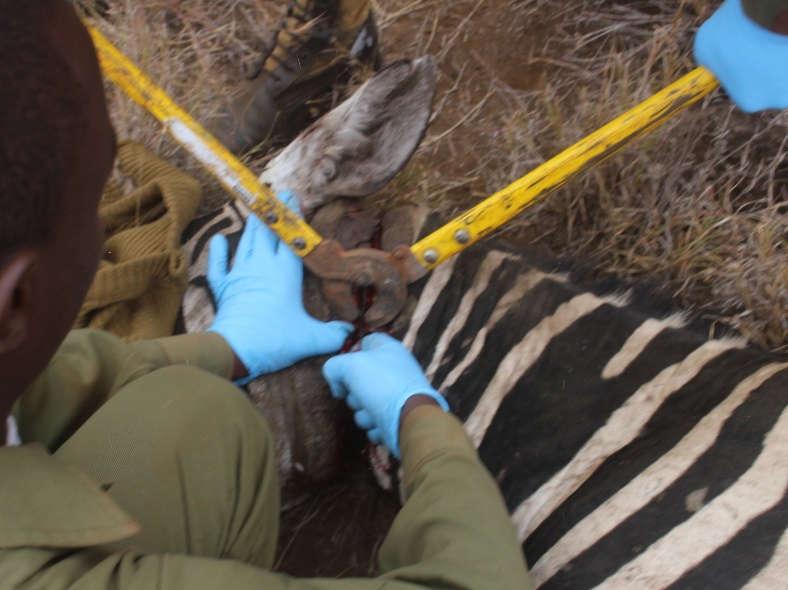

She was chemically retrained using a combination of 7mg Etorphine and 60mg of Azaperone. The drug took full effect after 12 minutes.
Examination revealed the wire snare was too tight and had cut deep into the neck muscle tissues and had partially severed the trachea. The wound was cleaned with Hydrogen peroxide, flushed with fresh water and disinfected using tincture of Iodine. Amoxicillin antibiotics and Flunixin meglumine anti-inflammatories were administered accordingly.
She could breathe easily with the wire removed though part of the exhaled air went through the perforated trachea. Surrounding tissues can regenerate through granulation with the tracheal opening closing substantially or even fully. Prognosis was considered favourable.
This elephant was observed to be struggling to get up early in the morning of this date by the Taita Sisal Ranch Wildlife Team. This mono-tusked elephant was found on left lateral recumbency. He was active and alert but had been struggling for a while as clear mucoid discharge seen on the ground.

This elephant was assisted to rise using a rope tied loosely round his tusk and pulled by two vehicles. He was able to rise up and join a group of bulls browsing nearby. A small discharging wound was observed on his left hind limb. He was agitated and the team decided to give him a chance to relax before being attended the next day. This would also give chance for the muscles to recover after prolonged recumbency.

He was seen a few days later and the Mobile Veterinary Team was called to treat. However, by the time the team arrived, he had collapsed. A treatment was conducted while he was lying down but he died despite the efforts. A poisoned arrowhead was retrieved from deep, the thigh muscles.
The elephant was observed by the SWT aerial patrol team to have suspected arrow wound on the left lateral side of his abdomen oozing pus and slightly swollen.

Immobilisation, examination and treatment
The elephant was chemically restrained using 20mg Etorphine hydrochloride from the air. The drug took full effect after 23 minutes.
Examination revealed an old healing arrow wound of about 6 inches in depth oozing pus. The wound was debrided using Hydrogen peroxide and flushed with fresh water. Tincture of Iodine was used for disinfection then natural green clay was packed into the wound. Amoxicillin antibiotics and Flunixin meglumine antiinflammatories were administered appropriately.
He was revived using 36mg Diprenorphine hydrochloride and 50mg Naltrexone and woke up about 2 minutes post revival and walked majestically deep into the bushes. He has a good prognosis
The Meru Vet Unit was called to attend to a male white rhino with a discarded fence wire entangling his hindlimbs.
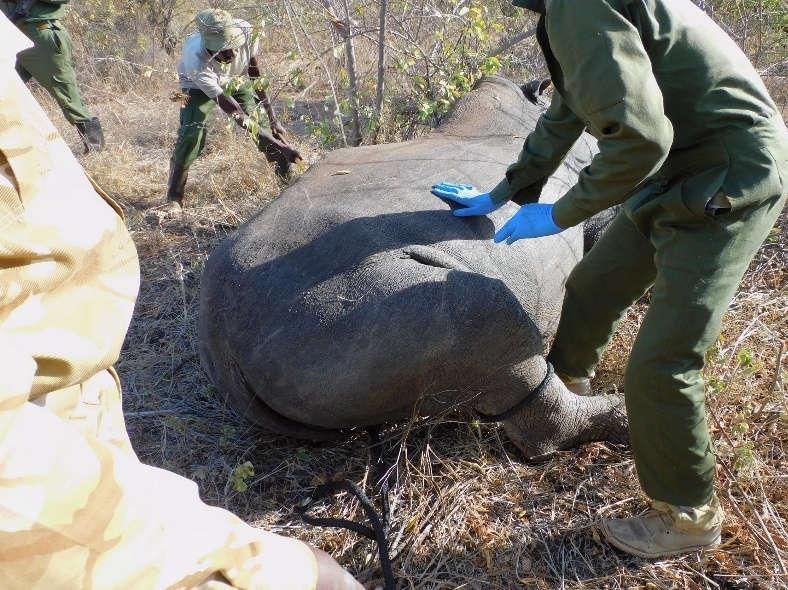
The rhino was immobilized by darting with 4 mg Etorphine and 60 mg Azaperone from a Sheldrick Wildlife Trust helicopter. This exercise was carried out in collaboration with the SWT/ KWS Mount Kenya Mobile Vet Unit. The animal was manoeuvred by the chopper to an open area and quickly restrained. A blindfold was then placed over his eyes to avoid ocular damage and visual excitation. 25 mg Butorphanol was administered intravenously to enhance breathing before a physical examination was carried out. It was observed that the loose fence wire had slipped off while the bull was being manoeuvred through the bush to an open area The wire had not caused any injury. Anaesthesia was reversed with 40 mg Naltrexone administered intravenously and 12 mg Diprenorphine administered intramuscularly to avoid re-narcotization. He rose 2 minutes later and walked away.


The fence wire did not cause any injury, so the rhino has a good prognosis
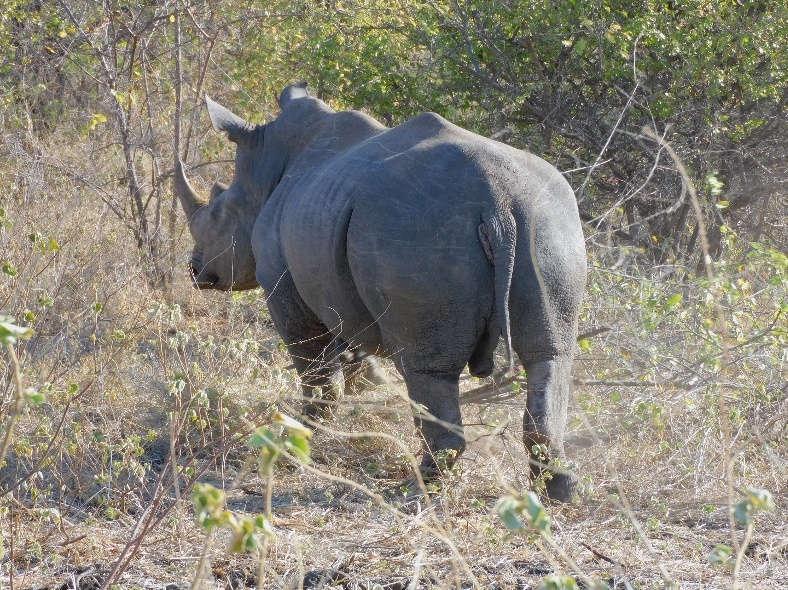
An arrowed buffalo was reported by the sanctuary rangers during their routine patrol in the sanctuary and a call to the Sheldrick Wildlife Trust who mobilised Sky Vets Unit for a quick response.




The adult bull buffalo was found grazing with other bulls within the sanctuary. Slight lameness was evident as the bull walked which had an arrow penetrating into the left caudal shoulder joint. 8mg of Etorphine and 180mg of Azaperone was prepared and the animal approached and darted from the vehicle. The animal fell on sternal recumbency. The arrow was removed with a forcep and a scalpel as it was a hooked one. The wound was thoroughly cleaned with hydrogen peroxide and a tincture of iodine. 6000mg of Oxytetracycline was given intramusculary. 40mg of Dexamethasone given intramusculary.
It was revived with 30mg Diprenorphine into the jugular vein. He was up on his legs after 7 minutes with little assistance using ropes around his horns and walked away to join the other herd. Prognosis is good.
The elephant was observed to be dragging a winch wire on the right hind limb by the SWT patrol teams at Galana Conservancy. The Mobile Veterinary Team was airlifted by the SWT helicopter to attend to the case.


The elephant was found deep within the bushes along Galana River dragging a winch wire tightly attached to his right ankle. The body condition was good. This majestic bull was chemically immobilized using 20mg etorphine hydrochloride delivered using a 3 ml Dan-inject dart from the air. The drug took full effect after 8 minutes with the elephant assuming left lateral recumbency.


The wire was cut loose and removed, with the resultant wound caused by the snare cleaned and disinfected with tincture of Iodine. The elephant was also given with Amoxicillin antibiotics and Flunixin meglumine antiinflammatories administered parenterally.
He was revived using 60mg of Diprenorphine hydrochloride given through a prominent ear vein and he got up after 2 minutes and walked into a thicket. Prognosis is good
Mara triangle rangers requested for a review of a previously treated giraffe. The giraffe had been treated for a wound which was suspected to have been caused by a snare on the lower left hock joint.
Slight lameness was observed and pus had drained from the wound.
Granulation tissue was observed to have formed around the wound. No evidence of maggots invasion was observed. Lameness should subside with time.
Clinical intervention was not necessary.
Prognosis is good.
No pictures are available for this case.
A speared hippopotamus was reported by the Conservancy Rangers during their routine patrol in the conservancy and a call was made to the Sheldrick Wildlife Trust Mara Vet Unit which responded immediately.

The spear was on the dorsal back of the animal at the level of thoracic vertebrae and was firmly attached to the well built muscles of the dorsal thorax.
Immobilising the animal at 4am as planned was a challenge due to the risk of drowning. Later mid-morning, an alternative method was used to remove the spear. A long metal bar with a hook proved successful and the spear was successfully removed from the hippo.
There was no evidence of infection as there was no discharge. This was a likely indication that the wound was superficial and is expected to heal progressively faster. No clinical intervention was advised.
Prognosis is good
An adult female elephant was spotted with slight lameness and swollen genitalia by Elephant Aware rangers during their routine patrol in the conservancy.
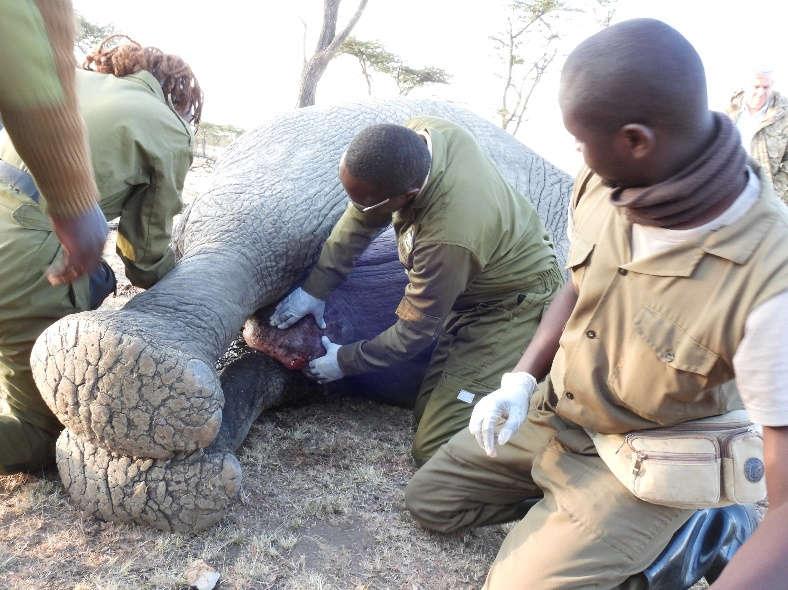



The female was found grazing along with its family members. She had a young calf about 1-2 years old. Slight lameness as she walked was evident. A swelling on the genitalia and lower abdomen was also observed.
17mg of the immobilizing drug Etorphine was prepared and the animal approached from a vehicle. The elephant was darted from the vehicle with the animal assumed left lateral recumbency.
The swelling on the vulva was diagnosed to be as a result of an infection leading to accumulation of serous fluid due to the inflammation. The swelling was incised and the fluid was drained. It was then cleaned with tincture of Iodine and amoxycillin was infused into the capsule. Amoxycillin L.A and a high dose of dexamethasone was also administered intramuscularly.
Prognosis is good Monitoring was advised and a review by the vet team after 14 days.
During their routine patrol in the reserve a zebra was observed with a swelling on the right flank and an arrowhead could be seen protruding from the injury.
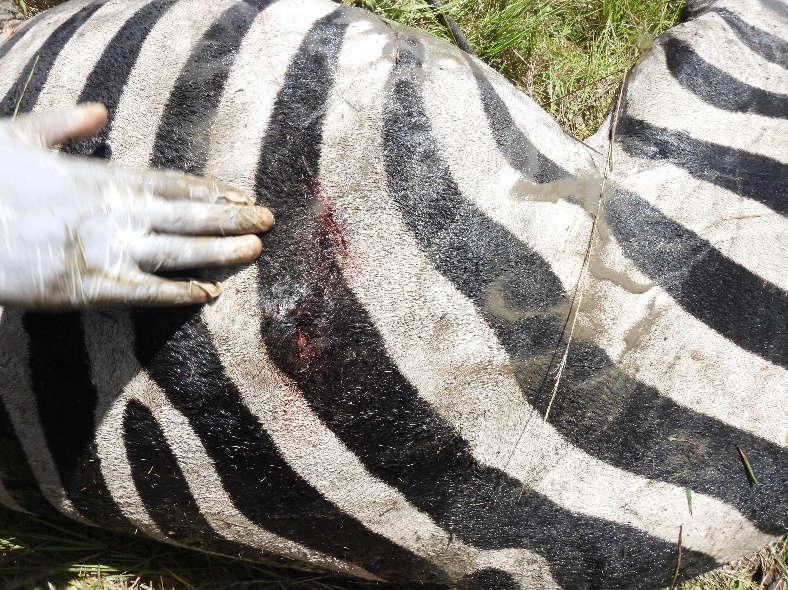
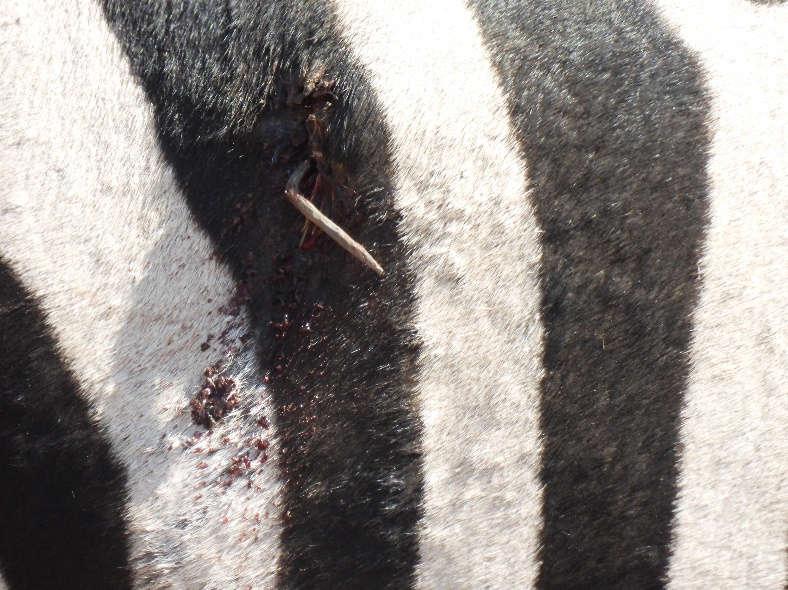
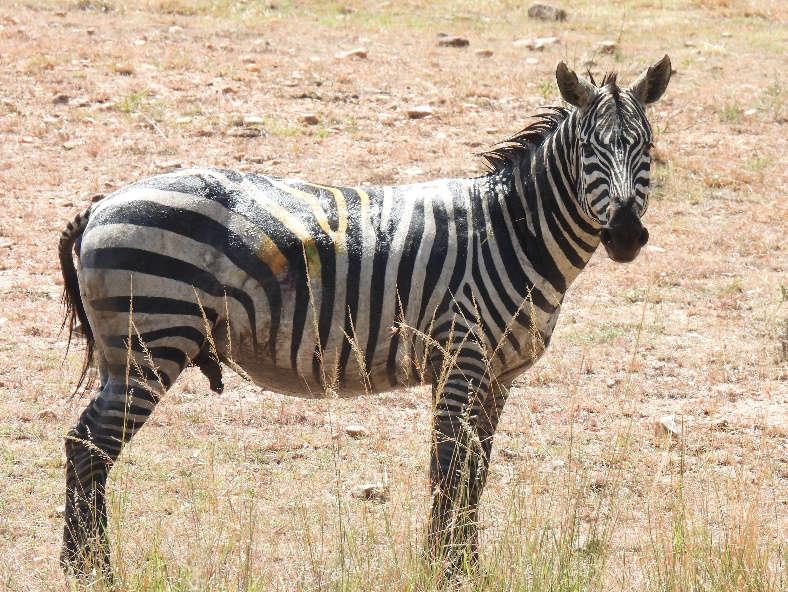
The adult zebra was found grazing with other wildlife within the reserve. 6mg Etorphine hydrochloride and 60mg of Azaperone was prepared and the animal was approached and darted from the vehicle. The animal did not go down on the first dart and thus a 2nd one was prepared. The zebra dashed into a nearby swamp forcing the team to get into the swamp so as to rescue and do the treatment.

The arrow was removed with the help of a forceps and a scalpel as it was a hooked one. The wound was thoroughly cleaned with Hydrogen peroxide and tincture of Iodine.6000mg of Oxytetracycline and 40ml of Dexamethasone were administered intramuscularly.
It was revived with 48 and 12 mg of diprenorphine intravenously and intramuscularly respectively Prognosis is good.
The SWT helicopter was called out to rescue a young 2-week-old female elephant that had been found abandoned on Ole Naishu Ranch in Laikipia.
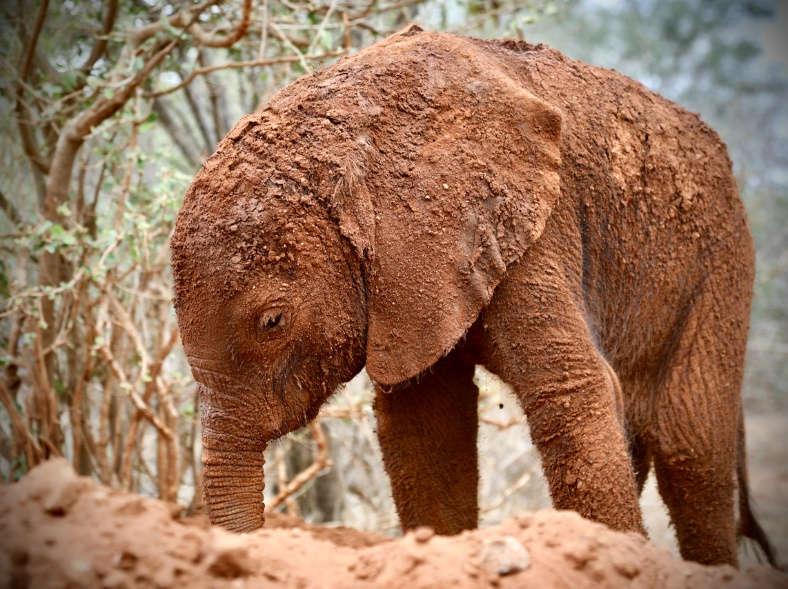




The SWT helicopter responded immediately and flew to the area where the calf had already been secured and awaited rescue. She immediately took milk, was safely placed on the aircraft and flown to the Kaluku Neo nate Stockade.

The lion was reported to the Veterinary team having been spotted lame near Porini Camp due to an injury after a territorial fight. There appeared to be an injury to the right forelimb.


The vet team attended to the case and a helicopter did a thorough search for the lion in the thickets within the general area where he had been sighted. The lion was flushed from a thicket and on observation, it was evident that he had suffered from an injury on the right fore limb.
Slight limping was observed but no physical injury was observed only a slight swelling on the affected limb. Reports from rangers in the area indicated that there was a territorial fight between two male lions and that the lameness was severe when first observed. It was decided to treat the lion without immobilization The lion was darted from the helicopter with 3 darts of 3.4 ml Phenylbutazone to ensure the pain and swelling are taken care of. The darts fell off immediately after darting.
The lion is in stable condition and the injury only affected the soft tissues with no traumatic injury to the bones and internal organs, hence quick recovery is expected. Rangers are advised to monitor the lion.
Rukinga ranch rangers saw an arrow lodged in the proximal trunk of this well-known female elephant with long nearly crossing tusks. The elephant appeared to be in pain, and part of the arrow’s shaft could be seen.
The elephant was found resting under a tree with her 3-year-old male calf. The elephant was darted from a vehicle with 18 mgs Etorphine hydrochloride. The drugs took full effect after 7 minutes with the female assuming left lateral recumbency. The arrow was gently removed then the penetrating wound was debrided with Hydrogen peroxide, rinsed with water and disinfected with Iodine. Cloxacillin antibiotic ointment was infused into the wound. Amoxicillin antibiotics and Flunixin meglumine anti-inflammatories were administered intramuscularly. Examination of the other side of the body showed an old arrow wound on her left armpit which had since healed. Anaesthesia was then reversed with 48 mgs Diprenorphine hydrochloride delivered through a prominent ear vein. The elephant struggled to rise, but it was successful after making a few attempts. A helicopter successfully guided the calf back to its mother


The elephant has a good prognosis since the arrow was not poisoned.
Rukinga Ranch rangers spotted this young calf (approx. 3 years old) with a snare around the neck. The calf was in a herd of about 15 elephants near a water tank.
It was difficult to separate the calf from the rest of the herd, therefore the calf was darted as the herd was driven away. From a helicopter, 3 mgs Etorphine was discharged with the Dan-Inject darting system. The drugs took effect after 4 minutes with the calf assuming recumbency in 6 minutes. Examination revealed a tight cable wire snare around the calf’s neck causing a deep wound. The snare was cut loose then the wound was debrided with Hydrogen peroxide, cleaned with water and disinfected with Iodine. Amoxicillin antibiotics and Flunixin meglumine anti-inflammatories were administered parenterally Anaesthesia reversal was achieved with 12 mgs Diprenorphine delivered through a prominent ear vein. The calf rose 2 minutes later, and the helicopter was used to guide it towards its family.

The calf has a good prognosis.

This elephant was seen within the same herd as the snared calf under case 7, the young bull (approx. 7 years old) was oozing purulent exudate from the left thigh.


The young bull was darted from a helicopter with 5 mgs Etorphine hydrochloride. The drugs took full effect after 7 minutes with the bull assuming right lateral recumbency. Examination revealed a deep wound filled with pus. The wound was most likely caused by an arrow though probing it yielded no foreign body. The pus was drained off, all necrotic tissue was debrided with Hydrogen peroxide then the wound was disinfected with Iodine. Amoxicillin antibiotics and Flunixin meglumine anti-inflammatories were given accordingly. Anaesthesia was reversed with 18 mgs Diprenorphine hydrochloride given intravenously through a prominent ear vein. The elephant rose 2 minutes post-reversal and found its way to its family a short distance away.
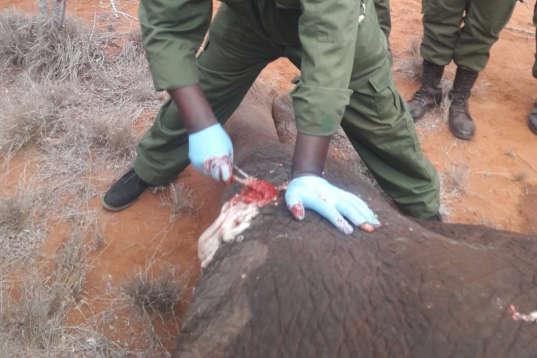

The elephant has a good prognosis.
Community members woke up to 2 elephants struggling to free themselves from a muddy dam in the area. Local KWS officers and Sheldrick Wildlife Trust were notified 3 days later after it became apparent that the elephant cow and her young calf were not going to be able to free themselves without assistance
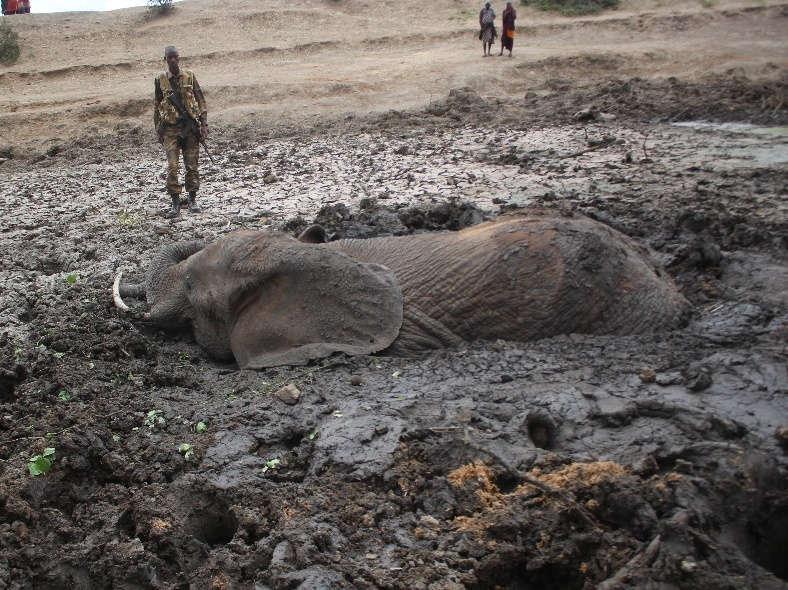
The elephants were found close to each other and stuck in the muddy dam. They appeared exhausted after a long struggle. Community members were providing them with water using buckets.
The team first embarked on pulling the adult female out of the muddy dam since she appeared to be more exhausted by the ordeal. The rescue was a challenge given the sloppy dam edges. Long ropes secured to a vehicle positioned outside the wall of the dam were used to pull the elephant out of the muddy dam

As soon as the elephant was on firm ground, she was allowed to rest briefly and stand on her own. She rose a few minutes later and dashed to a nearby bush. A tractor was used to pull the calf a few meters from where it was stuck, it stood up almost immediately and run to a nearby thicket.
The mother and calf have a good prognosis and are expected to continue with their lives normally.
A similar rescue involving another elephant cow and her calf was mounted a week earlier in the same dam.
In order to prevent similar occurrences, KWS, Sheldrick Wildlife Trust and county government teamed up to desilt and clean the dam in readiness for the rains.
Members
secured to a tree.
By the time the Veterinary Unit arrived, the elephant had freed itself. It was believed that a piece of the wire snare was still attached to the animal’s left forelimb. An aerial search for the elephant was therefore requested. The elephant was later found a long distance away from where it was snared. The bull had difficulty walking, and it had a slightly swollen left carpus. The elephant was darted from a helicopter with 20ml Etorphine hydrochloride, and the drugs took effect 8 minutes later. Examination of the limb revealed that the wire snare had fallen off. The limb had snare markings, and it was swollen at the carpal joint. Amoxicillin antibiotics and Flunixin anti-inflammatories were administered. Anaesthesia was then reversed with 60mg Naltrexone. The elephant was up 1-minute post-reversal and lingered briefly before walking away.
The elephant has a good prognosis.
Wildlife works rangers saw this giraffe dragging a big tree stump.
The giraffe was found dragging a huge tree stump attached to a cable wire snare tightly bound around the animal’s neck. The giraffe was in severe distress, and it was struggling to walk and breathe. The giraffe was approached on foot and darted with 13mg Etorphine hydrochloride and 60mg Azaperone. The drugs took full effect after 8 minutes.
The wire was cut off as the giraffe was revived with 48mg Diprenorphine given intravenously. Unfortunately, the cable snare was too tight and strangled the giraffe as it went down leading to a rupture of major blood vessels around the neck and a tear of the trachea as revealed by post-mortem carried out after the giraffe passed away.

The giraffe was seen by the KWS patrol team and the Conservancy Rangers dragging a nylon rope snare on its right hindlimb.


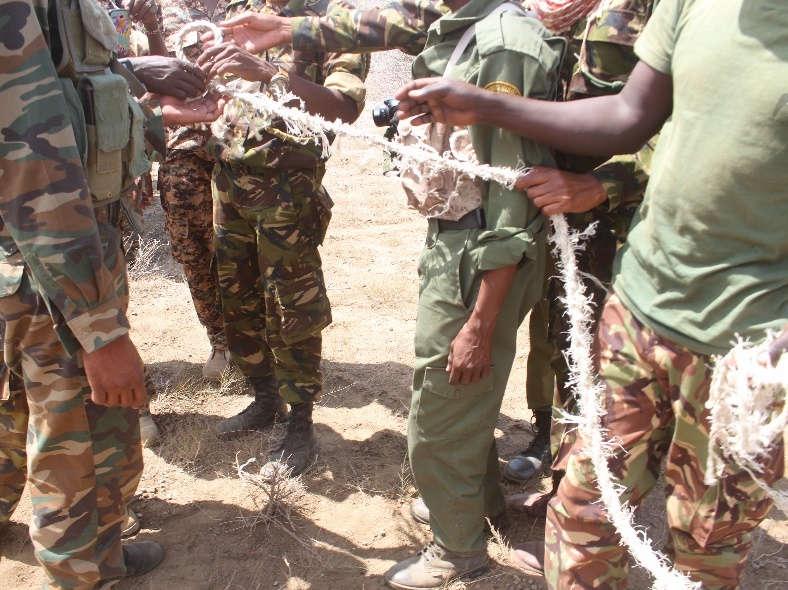
The giraffe was darted with 12mg Etorphine and 60mg Azaperone titrate. The drugs took full effect after 8 minutes. It was manually restrained, and anaesthesia reversed immediately with 48mg Diprenorphine.
The giraffe was noted to be in good body condition. The thick nylon rope snare on the giraffe’s right hindlimb was cut off. There being no physical injury, the giraffe was released thereafter and ran off to a safe distance.
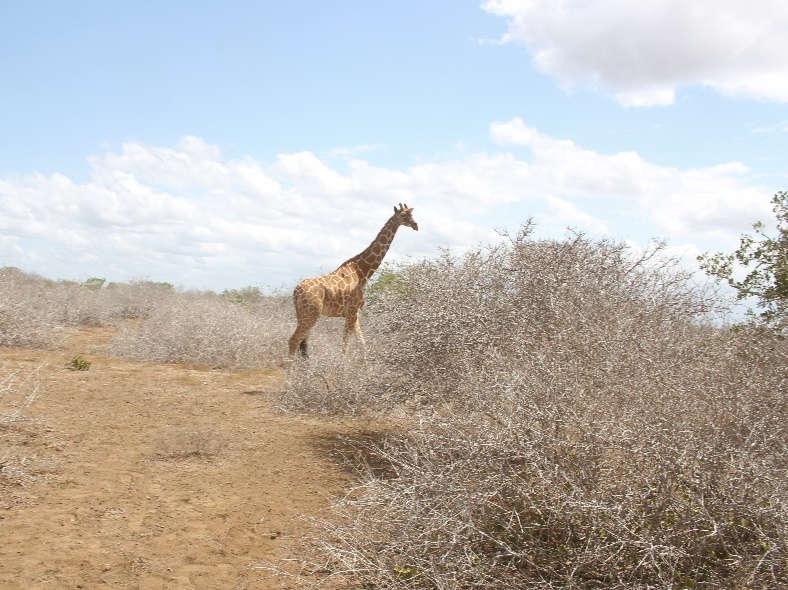
The giraffe has a good prognosis.
The Ol Pejeta team reported this case of a one-week-old black rhino found abandoned after surviving a hyena attack. The hyena had bitten off the rhino’s tail and some parts of its perineal region.



The calf was rescued by the Mt Kenya Veterinary Unit and flown by helicopter to the Sheldrick Wildlife Trust Nairobi Nursery for further treatment and care. The rhino calf was observed to be in good body condition and showed signs of aggression. It had no tail, and an open wound was observed at the perineal region with herniation of the intestines when straining
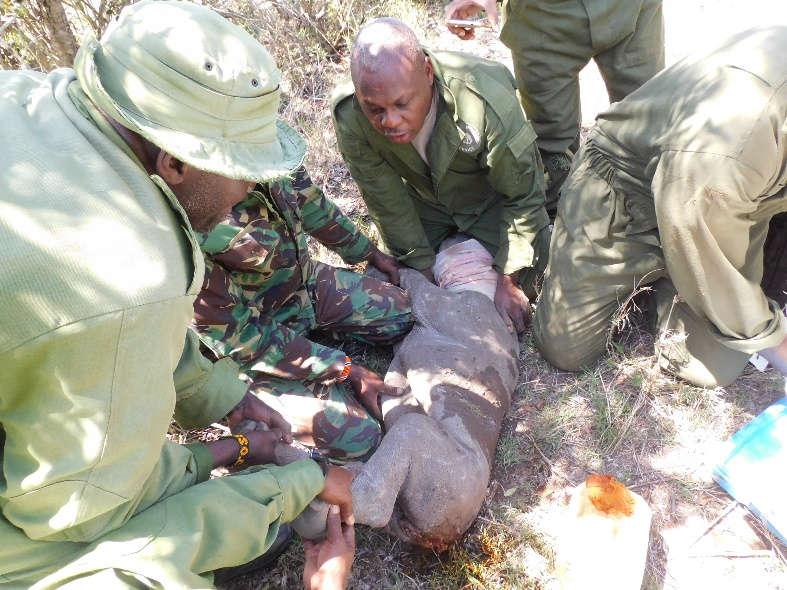
750mgs Amoxicillin and 250mgs Flunixine were administered intramuscularly. The wound was flushed with Iodine and sprayed with Oxytetracycline. As a first aid measure, the open wound was sutured with an absorbable suture to prevent herniation and prolapse of the rectum while straining. Reconstructive surgery of the perineal region is recommended
The rhino has a good prognosis